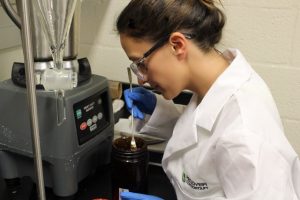Study Summarizes Laboratory Research on How Deepwater Horizon Oil Affects Fish
– NOVEMBER 20, 2019
Scientists synthesized data from 53 peer-reviewed laboratory studies that investigated how Deepwater Horizon oil may affect 20 ray-fin fish species. Of the species tested, 20% show effects at oil concentrations of <1 μg l−1 and 50% display effects at <8.6 μg l−1 ΣPAH50, concentrations well within the range of reported environmental levels during the spill. The most frequently reported impact was reduced cardiac function, which could contribute to effects on fitness and survival. However, a few studies found that sensory function, sensory organ development, and behavior were affected at even lower exposure concentrations, suggesting that these may be more sensitive than cardiovascular impairment. Most studies examined early life stage fish, which showed higher sensitivity to oil exposure than adult fish (1-2 orders of magnitude); however, the few studies on adult fish indicated impacts on them at low oil concentrations. Oil toxicity presents as a multi-target, multi-organ syndrome with substantial sensitivity differences among species (2-3 orders of magnitude variation). These findings suggest that future investigations should measure several sublethal endpoints, rather than solely focusing on mortality. In addition, data suggests that certain species are more suitable than others for oil spill impact assessments.
The researchers published their findings in Comparative Biochemistry and Physiology, Part C: Impacts of Deepwater Horizon oil on fish.
Following Deepwater Horizon, the research community began investigations into how the oil spill might affect marine life, especially commercially and recreationally important fisheries. This synthesis effort sought to explore reported trends in species sensitivity and differences in sensitivity among endpoints, taking into consideration exposure duration, life stage, and temperature. The authors selected studies that characterized, measured, and reported exposure concentrations of polycyclic aromatic hydrocarbons (PAHs) and excluded population-level field studies that did not characterize PAH exposure concentrations because of interpretation challenges.
“Although each oil spill is unique due to the distinctive chemical characteristics of a given type of crude oil, the injury phenotype of crude oil exposure is found to be highly conserved,” explained study author Christina Pasparakis. “Consistent physiological and anatomical abnormalities are found to occur among different species and between different spills. Investigating the overall impacts of this ecological disaster is not only critical to understanding the damage caused to the ecosystems and organisms affected, but it will also help us better prepare for the inevitability of future oil spills.”
The majority of studies included in this review received funding from the National Oceanic and Atmospheric Administration under the Natural Resource Damage Assessment effort and the Gulf of Mexico Research Initiative. Most studies conducted acute water-borne exposures (1–2 days) at mid-range test temperatures (26–28 °C) and measured effects at the molecular to organismal levels. The most studied species were mahi-mahi (16 publications), followed by red drum (6 publications) and sheepshead minnow (5 publications).
The authors noted data voids for temperatures at the lower and upper range for the Gulf of Mexico and for adult, young adult, and juvenile fish, which may experience more effects at concentrations only slightly above those that impact early life stage fish. They explained that morphological defects affecting fitness and survival reported for early life stage fish are unlikely to manifest fully until later as fish grow and develop, affecting their swim performance, prey capture, and predator avoidance traits.
The authors suggested that measures of growth and mortality during acute exposures, as was measured in most of the reviewed studies, may not accurately display an organism’s true sensitivity. “Sublethal impacts can have latent and significant effects on organisms’ chances of survival to later life stages,” explained Pasparakis.
Comparison of oil-induced mortality with additional environmentally relevant stressors is another understudied and critical area of investigation that the authors identified, which limits understanding of the overall damages resulting from this environmental perturbation.
“When assessing impacts of disastrous environmental events, such as oil spills, the ultimate concern is most commonly population and ecosystem level impacts with a specific focus on species of high economic value,” explained Pasparakis. “Yet, of the 53 studies included in this present review which were limited to those reporting exposure concentrations, none addressed impacts at the population or ecosystem levels. Thus, when assessing the impacts of the 2010 spill, it is the task of the scientific community to link knowledge gained from studies at lower levels of biological organization to impacts on ecosystems.”
The study’s authors are Christina Pasparakis, Andrew J. Esbaugh, Warren Burggren, and Martin Grosell.
By Nilde Maggie Dannreuther and Stephanie Ellis. Contact maggied@ngi.msstate.edu with questions or comments.
************
This research was made possible in part by a grant from the Gulf of Mexico Research Initiative (GoMRI) to the Relationship of Effects of Cardiac Outcomes in Fish for Validation of Ecological Risk II (RECOVER II) consortium.
The Gulf of Mexico Research Initiative (GoMRI) is a 10-year independent research program established to study the effect, and the potential associated impact, of hydrocarbon releases on the environment and public health, as well as to develop improved spill mitigation, oil detection, characterization and remediation technologies. An independent and academic 20-member Research Board makes the funding and research direction decisions to ensure the intellectual quality, effectiveness and academic independence of the GoMRI research. All research data, findings and publications will be made publicly available. The program was established through a $500 million financial commitment from BP. For more information, visit https://gulfresearchinitiative.org/.
© Copyright 2010-2019 Gulf of Mexico Research Initiative (GoMRI) – All Rights Reserved. Redistribution is encouraged with acknowledgement to the Gulf of Mexico Research Initiative (GoMRI). Please credit images and/or videos as done in each article. Questions? Contact web-content editor Nilde “Maggie” Dannreuther, Northern Gulf Institute, Mississippi State University (maggied@ngi.msstate.edu).






